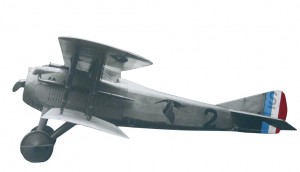This plane is the SPAD VII No. S 254 belonging to the famous airman, Georges Guynemer (1894-1917), on display in the main courtyard of the Invalides on 20 October 1917.
A few weeks earlier, on 11 September 1917, Guynemer was killed on board another plane, when he was only 23 years old. This close-up of the plane allows its name, Vieux Charles to be seen as well as the stork in flight, the emblem of squadron n°3 since July 1916. The figure 2 is Guynemer’s own specific number within squadron SPA 3 (the new name given to it in October 1917), each pilot had his own personal number. The plane is armed with a machine-gun that the pilot himself fired: in fact, there was only one seat in this plane. The plane’s tail carries the French ace’s tricoloured band.
as the stork in flight, the emblem of squadron n°3 since July 1916. The figure 2 is Guynemer’s own specific number within squadron SPA 3 (the new name given to it in October 1917), each pilot had his own personal number. The plane is armed with a machine-gun that the pilot himself fired: in fact, there was only one seat in this plane. The plane’s tail carries the French ace’s tricoloured band.
Guynemer was considered as one of the aces of French aviation. In principle, an «ace» must have five aerial combat victories to his credit, similarly to the five symbols on the «Ace» playing card. The French system for victory certification required that the aircraft shot down should fall on the allied side of the front line and that there should be at least two witnesses on the ground.
A cumbersome resident
After the war, the Vieux Charles left the main courtyard for the room in the Musée de l’Armée devoted to Guynemer. It was then suspended from the ceiling of one of the staircases leading to the upper gallery of the main courtyard. Exposed to the weather, it deteriorated. Today, it is in the Musée de l’Air et de l’Espace, at Le Bourget, after having been fully restored.




Ajouter un commentaire